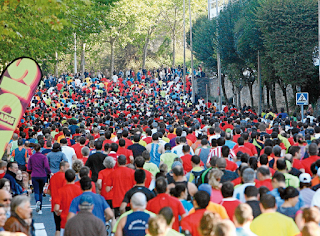ENTROIDO - and entire Galicia is partying!
 |
| (source: wikicommons) |
What's this "entroido" everybody is talking about lately in Santiago?
Well, if you don't know that "entroido" means "carnival" in Galician it's quite hard to associate all the parties, disguises and the special food this magic word is implying.
Well, if you don't know that "entroido" means "carnival" in Galician it's quite hard to associate all the parties, disguises and the special food this magic word is implying.
Generally, celebrating carnival is a phenomenon present in many different cultures of the world, whether the famous "Carnaval de Rio de Janeiro", the German and Austrian "Fasching" or "Fasnacht", or the "Mardi Gras" in New Orleans - carnival is everywhere! However, this article is going to present you a type of carnival which is unique in Spain, full of strange stuff as "peliqueiros", "cigarrones", "gaitas", "queimada" y "orellas" (the last two terms being food) - in one word, "entroido", the carnival of Galicia!
The magic triangle of "entroido"
In Galicia there are three villages in the area of Ourense which form the "magic triangle of entroido". They are called Xinzo, Laza and Verin; every year they attract ten-thousands of visitors who want to be part of the carnival events in the small villages. In the entire region, with five Sundays of carnvial, Xinzo de Limio has the longest carnival period which stops with the period of fasting.
In Galicia there are three villages in the area of Ourense which form the "magic triangle of entroido". They are called Xinzo, Laza and Verin; every year they attract ten-thousands of visitors who want to be part of the carnival events in the small villages. In the entire region, with five Sundays of carnvial, Xinzo de Limio has the longest carnival period which stops with the period of fasting.
The different holidays - the war of the flour is declared!
In the village Viana del Bollo the "Jueves de Compadres" ("Thursday of [male] friends") takes place, in which the boys of the village throw flour at the girls. However, the "Jueves de Comadres" ("Thursday of [female] friends) offers an opportunity of revenge to the girls: now they are the ones throwing flour at the boys. In addition to that, in the area of Laza they celebrate as well the "Lunes the Farrapos" ("Monday of rags"). In the main square, a kind of tart fight takes place, only that instead of cake, wet and dirty rags are the weapons.
The disguises
 The traditional disguise in the area of the "magic triangle" is called "peliqueiro" and consists of white trousers with ruches, worn over patterned thighs and with two garters. In addition to that, the "peliqueiros" wear a heavy mask made from wood - in total, the weight of the disguise can reach 30 kg! Naturally, the disguises and masks are produced in the area of Laza, where the events take place. The disguise is quite expensive; a "suit" can cost until 3.000 Euros and the masks between 300 and 400. The symbols on the big wooden masks depend on the area and the village, but usually they are decorated with illustrations of wild animals like tigers, wolves, lynxes..
The traditional disguise in the area of the "magic triangle" is called "peliqueiro" and consists of white trousers with ruches, worn over patterned thighs and with two garters. In addition to that, the "peliqueiros" wear a heavy mask made from wood - in total, the weight of the disguise can reach 30 kg! Naturally, the disguises and masks are produced in the area of Laza, where the events take place. The disguise is quite expensive; a "suit" can cost until 3.000 Euros and the masks between 300 and 400. The symbols on the big wooden masks depend on the area and the village, but usually they are decorated with illustrations of wild animals like tigers, wolves, lynxes..
In summary, the "entroido" is an importan Galician tradition which is far from being extinct: even though the population of the villages decreases continually (there live about 2,500 people in the entire municipality), there are more and more "peliqueiros" every year.
 |
| (source: "Voz de Galicia) |
The disguises
 The traditional disguise in the area of the "magic triangle" is called "peliqueiro" and consists of white trousers with ruches, worn over patterned thighs and with two garters. In addition to that, the "peliqueiros" wear a heavy mask made from wood - in total, the weight of the disguise can reach 30 kg! Naturally, the disguises and masks are produced in the area of Laza, where the events take place. The disguise is quite expensive; a "suit" can cost until 3.000 Euros and the masks between 300 and 400. The symbols on the big wooden masks depend on the area and the village, but usually they are decorated with illustrations of wild animals like tigers, wolves, lynxes..
The traditional disguise in the area of the "magic triangle" is called "peliqueiro" and consists of white trousers with ruches, worn over patterned thighs and with two garters. In addition to that, the "peliqueiros" wear a heavy mask made from wood - in total, the weight of the disguise can reach 30 kg! Naturally, the disguises and masks are produced in the area of Laza, where the events take place. The disguise is quite expensive; a "suit" can cost until 3.000 Euros and the masks between 300 and 400. The symbols on the big wooden masks depend on the area and the village, but usually they are decorated with illustrations of wild animals like tigers, wolves, lynxes..In summary, the "entroido" is an importan Galician tradition which is far from being extinct: even though the population of the villages decreases continually (there live about 2,500 people in the entire municipality), there are more and more "peliqueiros" every year.




Comments